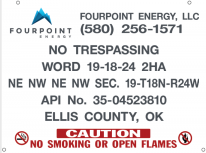In a recent blog post, I made the claim that API numbers make lousy corporate Well ID’s, which I was happy to see stirred up some agreement in the O&G data community (along with some disagreement!). Now that we have torn the venerable API number down, it’s time to build it back up.
So, what are API numbers good for, anyways?
There are three business workflows that I have found API numbers to be essential for:
- Working with public data
- Exchanging data between companies
- Building your Corporate Well ID
Putting the “American” in API Number
While not all states adhere to this, the vast majority of useful data reported to the states in the U.S. comes attached to an API number. Key states like Colorado, North Dakota, and Oklahoma make it easy to look wells up using an API number, leading to data like wellbore configurations, monthly well-level production reports, log/core data, and more.
I’ve generally found that API numbers are most useful when sticking with just well header or completion data. Notice that websites like FracFocus work well with simple 10-digit API numbers (no dashes, though!). Well logs, perforations, core data and more are almost always cleanly tied to an API number, no matter what state you’re in.
Using 10-digit API numbers starts to break down when moving towards production data, but it’s usually solvable with some workarounds. In most states, aggregating to an API 10 level will give you useful data for workflows like reserves, production surveillance, and reservoir characterization. Texas, of course, makes this much more difficult, since oil leases are reported at the lease level, not the well level. It’s a giant exception to how API’s are usually useful for public data work. And yet it unfortunately appears to be a permanent feature of the Railroad Commission’s rules.
Exchanging Data Between Companies
API numbers have settled in as the de facto way for operators, oilfield service companies (OFS), midstream companies, and regulators to share data on wells. With dense, multi-well development programs happening on modern drilling sites, clear usage of API numbers reduces confusion, shortens communication times, and improves quality of service.
This is a Good Thing, and people who care about data quality should encourage more of this! Make API number an input field on field tickets, invoices, price quotes, and post-job reports. Clearly communicate with your business partners on when to use API10 vs. API14. And never accept “Smith #1” from an OFS provider when an API number is available! It’s often written right there on the wellhead sign!

Not all service work takes place at the well level, of course – facilities construction, gas sales, and lots of other important stuff takes place at a pad or battery level. But even in those cases, API numbers from an associated wellbore can help with things like wellsite navigation and verifying that the work is getting done on the right site.
One huge frustration for many non-op/royalty owners is that Operators underutilize API numbers when it comes to sending JIBs and revenue statements. No one cares about your Cost Center Code, but adding API numbers to check detail statements and CAPEX/OPEX JIBs makes life much easier for your revenue owners. Come on, accounting departments, get with the API program!
Building Your Corporate Well ID
The motivation for my original rant/blog post was specifically around how they make lousy Corporate Well IDs, and I’ll stick to that as long as I live. That said, if you’re trying to assign Well ID’s to Cost Centers, Leases, and other business objects, API numbers can really come in handy as you’re building a Corporate Well ID.
The general process here is threefold: 1) get system owners to assign as many as possible, 2) match across systems and map out 1:Many and Many:1 relationships, and then 3) assign Corporate Well ID’s back to source systems. In my experience, using API numbers to assign ID’s across systems can get you at least to a 50% answer, and often 80 or 90%. No reason to argue if Accounting, Land, Reserves, and Operations all carry the same well as the same API number. That will leave more time available to focus on what really matters: the last 10-20% of wells with weird back stories like recompletes, sidetracks, multi-well cost centers, and depth-severed Pugh clauses.
API’s and Other TLA’s
Like all good Three Letter Acronyms, the API number gets a lot of criticism, and for good reason if you’re using them poorly. But stick to workflows like public data, inter-company data exchange, and building your corporate Well ID’s, and you’ll find API numbers will help you give your XLS some TLC.
Give us a call if you’re struggling with this kind of thing, it’s our wheelhouse!


